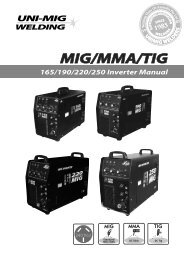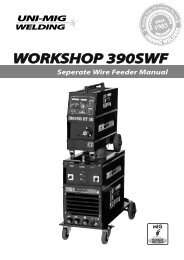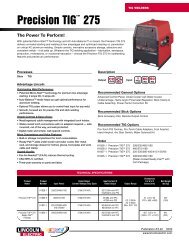Cleaning, Care & Maintenance of Stainless Steel - BJH
Cleaning, Care & Maintenance of Stainless Steel - BJH
Cleaning, Care & Maintenance of Stainless Steel - BJH
You also want an ePaper? Increase the reach of your titles
YUMPU automatically turns print PDFs into web optimized ePapers that Google loves.
<strong>Cleaning</strong>, <strong>Care</strong> & <strong>Maintenance</strong> <strong>of</strong><br />
<strong>Stainless</strong> <strong>Steel</strong><br />
Tech Note<br />
no. 5<br />
The attractive and hygienic surface appearance <strong>of</strong> stainless steel products cannot be<br />
regarded as completely maintenance free. All grades and finishes <strong>of</strong> stainless steel may<br />
in fact stain, discolour or attain an adhering layer <strong>of</strong> grime in normal service. To achieve<br />
maximum corrosion resistance the surface <strong>of</strong> the stainless steel must be kept clean.<br />
Provided the grade, condition and surface finish were correctly selected for the<br />
particular service environment, fabrication and installation procedures were correct and<br />
that cleaning schedules are carried out regularly, good performance and long life will be<br />
achieved. Frequency and cost <strong>of</strong> cleaning <strong>of</strong> stainless steel is lower than for many other<br />
materials and this will <strong>of</strong>ten out-weigh higher acquisition costs.<br />
These principles apply whether the item concerned is a simple kitchen utensil or a large<br />
and complex architectural installation.<br />
Why <strong>Maintenance</strong> is Necessary<br />
Surface contamination and the formation <strong>of</strong> deposits are critical factors which may lead<br />
to drastically reduced life. These contaminants may be minute particles <strong>of</strong> iron or rust<br />
from other non-stainless steels used in nearby construction and not subsequently<br />
removed. Industrial, commercial and even domestic and naturally occurring<br />
atmospheric conditions can result in deposits which can be quite corrosive. An example<br />
is salt deposits from marine conditions.<br />
Working environments can also create more aggressive conditions, such as the warm,<br />
high humidity atmosphere above indoor swimming pools. This particular environment<br />
has in a small number <strong>of</strong> instances been found to be highly aggressive, and specialist<br />
advice should be obtained.<br />
Aggressive operating environments can increase the speed <strong>of</strong> corrosion and therefore<br />
require more frequent maintenance. Modern processes use many cleaners, sterilisers<br />
and bleaches for hygienic purposes. These proprietary solutions, if appropriate for use<br />
with stainless steel and when used in accordance with their makers' instructions are<br />
safe, but if used incorrectly (e.g. warm or concentrated) can cause discolouration and<br />
corrosion on the surface <strong>of</strong> stainless steels.<br />
<strong>Maintenance</strong> During Installation<br />
<strong>Cleaning</strong> <strong>of</strong> new fabrications should present no special problems, although more<br />
attention may be required if the installation period has been prolonged. Where surface<br />
contamination is suspected, immediate attention to cleaning will promote a trouble-free<br />
service life. Food handling, pharmaceutical and aerospace applications may require<br />
extremely high levels <strong>of</strong> cleanliness.<br />
Strong acid solutions (e.g. hydrochloric acid or “spirits <strong>of</strong> salts”) are sometimes used to<br />
clean masonry and tiling during building construction but they should never be<br />
permitted to come into contact with metals, including stainless steel. If this should<br />
happen the acid solution must be removed immediately by copious water flushing, but<br />
even if promptly removed the appearance <strong>of</strong> the steel may be unacceptably changed.<br />
Revised May 2006 1 <strong>of</strong> 5
Atlas Specialty Metals<br />
<strong>Cleaning</strong>, <strong>Care</strong> & <strong>Maintenance</strong> <strong>of</strong><br />
<strong>Stainless</strong> <strong>Steel</strong><br />
Tech Note no. 5<br />
On-Going <strong>Maintenance</strong><br />
Advice is <strong>of</strong>ten sought concerning the frequency <strong>of</strong> cleaning <strong>of</strong> products made <strong>of</strong><br />
stainless steel, and the answer is quite simply “clean the metal when it is dirty in order<br />
to restore its original appearance”. A rule <strong>of</strong> thumb for many exterior building<br />
installations is to clean the stainless steel whenever the nearby glass needs cleaning.<br />
This may vary from once to four times a year for external applications or it may be once<br />
a day for an item in hygienic or aggressive situations. In many applications the cleaning<br />
frequency is after each use. Suggested cleaning intervals are as in this table – these<br />
should be modified by experience. Note that natural rain is an effective cleaner – those<br />
items that are not washed by rain water may need more frequent maintenance<br />
cleaning.<br />
Environment Grade 304 Grade 316<br />
Clean inland 3 – 6 months 6 – 12 months<br />
Polluted urban or industrial Not suitable 6 – 12 months<br />
Coastal / Marine (not splashed) Not suitable 3 – 6 months<br />
Good Housekeeping During Manufacture<br />
<strong>Stainless</strong> steel can be contaminated by pick-up <strong>of</strong> carbon steel (“free iron”) and this is<br />
likely to lead to rapid localised corrosion. The ideal is to have workshops and machinery<br />
dedicated to only stainless steel work, but in a workshop also processing other steels<br />
avoid pick-up from:<br />
• Tooling used with other metals<br />
• <strong>Steel</strong> storage racks<br />
• Handling Equipment<br />
• Grinding wheels, wire brushes, finishing belts<br />
• Contamination by grinding or welding sparks from adjacent carbon steel fabrication<br />
<strong>Cleaning</strong> Methods<br />
Sections below give passivation treatments for removal <strong>of</strong> free iron and other<br />
contamination resulting from handling, fabrication, or exposure to contaminated<br />
atmospheres, and pickling treatments for removal <strong>of</strong> high temperature scale from heat<br />
treatment or welding operations.<br />
Passivation Treatments<br />
• Grades with at least 16% chromium (except free machining grade such as 303):<br />
20-50% nitric acid, at room temperature to 40 o C for 30-60 minutes.<br />
• Grades with less than 16% chromium (except free machining grades such as 416):<br />
20-50% nitric acid, at room temperature to 40 o C for 60 minutes.<br />
• Free machining grades such as 303, 416 and 430F:<br />
20-50% nitric acid + 2-6% sodium dichromate, at room temperature to 50 o C for 25<br />
40 minutes.<br />
Revised May 2006 2 <strong>of</strong> 5
Atlas Specialty Metals<br />
<strong>Cleaning</strong>, <strong>Care</strong> & <strong>Maintenance</strong> <strong>of</strong><br />
<strong>Stainless</strong> <strong>Steel</strong><br />
Tech Note no. 5<br />
Pickling Treatments<br />
• All stainless steels (except free machining grades):<br />
8-11% sulphuric acid, at 65 to 80 o C for 5-45 minutes.<br />
• Grades with at least 16% chromium (except free machining grades):<br />
15-25% nitric acid + 1-8% hydr<strong>of</strong>luoric acid, at 20 to 60 o C for 5-30 minutes.<br />
• Free machining grades and grades with less than 16% chromium such as 303, 410<br />
and 416:<br />
10-15% nitric acid + 0.5-1.5% hydr<strong>of</strong>luoric acid, at 20 to 60 o C for 5-30 minutes.<br />
“Pickling Paste” is a commercial product <strong>of</strong> hydr<strong>of</strong>luoric and nitric acids in a thickener -<br />
this is useful for pickling welds and spot contamination, even on vertical and<br />
overhanging surfaces.<br />
Recommendations for <strong>Cleaning</strong> <strong>of</strong> Specific Products<br />
<strong>Stainless</strong> steel is easy to clean compared to many other materials. Washing with soap<br />
or a mild detergent and warm water followed by a clean water rinse is usually quite<br />
adequate for domestic and architectural equipment. An enhanced appearance will be<br />
achieved if the cleaned surface is finally wiped dry. Specific methods <strong>of</strong> cleaning are as<br />
in the table on the next page. These are recommendations only, and it must be<br />
recognised that there are risks associated with all cleaning operations. All such<br />
treatments must be evaluated by the user.<br />
PROBLEM CLEANING AGENT COMMENTS<br />
Soap or mild detergent and<br />
water. (preferably warm)<br />
Routine cleaning<br />
All finishes<br />
Fingerprints<br />
All finishes<br />
Stubborn stains and<br />
discolouration.<br />
All finishes.<br />
Lime deposits from<br />
hard water.<br />
Oil or grease marks.<br />
All finishes.<br />
Soap and warm water or<br />
organic solvent (eg acetone,<br />
alcohol, methylated spirits)<br />
Mild cleaning solutions. Ensure<br />
any proprietary cleaners state<br />
compatibility with stainless<br />
steel. Phosphoric acid cleaners<br />
may also be effective.<br />
Solution <strong>of</strong> one part vinegar to<br />
three parts water.<br />
Organic solvents (eg. acetone,<br />
alcohol, methylated spirits,<br />
proprietary “safety solvents”).<br />
Baked-on grease can be<br />
s<strong>of</strong>tened beforehand with<br />
ammonia.<br />
Sponge, rinse with clean<br />
water, wipe dry if<br />
necessary. Follow polish<br />
lines.<br />
Rinse with clean water and<br />
wipe dry. Follow polish<br />
lines.<br />
Use rag, sponge or fibre<br />
brush (s<strong>of</strong>t nylon or natural<br />
bristle. An old toothbrush<br />
can be useful). Rinse well<br />
with clean water and wipe<br />
dry. Follow polish lines.<br />
Soak in solution then brush<br />
to loosen. Rinse well with<br />
clean water.<br />
Clean after with soap and<br />
water, rinse with clean<br />
water and dry. Follow polish<br />
lines.<br />
Revised May 2006 3 <strong>of</strong> 5
Atlas Specialty Metals<br />
<strong>Cleaning</strong>, <strong>Care</strong> & <strong>Maintenance</strong> <strong>of</strong><br />
<strong>Stainless</strong> <strong>Steel</strong><br />
Tech Note no. 5<br />
(cont)<br />
PROBLEM CLEANING AGENT COMMENTS<br />
Rust and other<br />
corrosion products.<br />
Embedded or<br />
adhering “free iron”.<br />
Routine cleaning <strong>of</strong><br />
boat fittings.<br />
Cooking pot boiled<br />
dry.<br />
Dark oxide from<br />
welding or heat<br />
treatment.<br />
Scratches on<br />
polished (satin or<br />
brushed) finish.<br />
Very light rust stains can be<br />
removed by 10% nitric acid.<br />
More significant rust or<br />
embedded iron will require<br />
pickling. See also previous<br />
sections on Passivating and<br />
Pickling. Sand or glass-bead<br />
blasting is another option.<br />
Frequent washing down with<br />
fresh water.<br />
Remove burnt food by soaking<br />
in hot water with detergent,<br />
baking soda or ammonia.<br />
“Pickling Paste” or pickling<br />
solutions given on previous<br />
page.<br />
Slight scratches - use<br />
impregnated nylon pads.<br />
Polish with polishing wheel<br />
dressed with iron-free<br />
abrasives for deeper scratches.<br />
Follow polish lines. Then clean<br />
with soap or detergent as for<br />
routine cleaning.<br />
Wear PPE as appropriate.<br />
Afterwards rinse well with<br />
clean water. Mix in acidpro<strong>of</strong><br />
container, and be<br />
very careful with the acid.<br />
(see Precautions for acid<br />
cleaners)<br />
Recommended after each<br />
time the boat is used in salt<br />
water.<br />
Afterwards clean and<br />
polish, with a mild abrasive<br />
if necessary. See comments<br />
re steel wool.<br />
Must be carefully rinsed,<br />
and use care in handling<br />
(see Precautions for acid<br />
cleaners).<br />
Do not use ordinary steel<br />
wool - iron particles can<br />
become embedded in<br />
stainless steel and cause<br />
further surface problems.<br />
<strong>Stainless</strong> steel and “Scotchbrite”<br />
scouring pads are<br />
satisfactory.<br />
Precautions<br />
Acids: should only be handled using personal protective equipment as detailed in<br />
relevant MSDS and other product-specific information. <strong>Care</strong> must be taken that acids are<br />
not spilt over adjacent areas. All residues must be flushed to a treated waste stream<br />
(refer to local water authorities for regulations and assistance). Always dilute by adding<br />
acid to water, not water to acid. Use acid-resistant containers, such as glass or plastics.<br />
If no dulling <strong>of</strong> the surface can be tolerated a trial treatment should be carried out;<br />
especially for pickling operations. All treatments must be followed by thorough rinsing.<br />
Solvents: should not be used in confined spaces. Smoking must be avoided when using<br />
solvents.<br />
Chlorides: are present in many cleaning agents. This entails risk <strong>of</strong> pitting corrosion <strong>of</strong><br />
stainless steel. If a cleaner containing chlorine, chlorides, bleaches or hypochlorites is<br />
used it must be afterwards promptly and thoroughly cleaned <strong>of</strong>f.<br />
Revised May 2006 4 <strong>of</strong> 5
Atlas Specialty Metals<br />
<strong>Cleaning</strong>, <strong>Care</strong> & <strong>Maintenance</strong> <strong>of</strong><br />
<strong>Stainless</strong> <strong>Steel</strong><br />
Tech Note no. 5<br />
References for Further Reading<br />
“Standard Practice for <strong>Cleaning</strong> and Descaling <strong>Stainless</strong> <strong>Steel</strong> Parts, Equipment, and<br />
Systems”, ASTM A380, American Society for Testing and Materials.<br />
“Successful use <strong>of</strong> <strong>Stainless</strong> <strong>Steel</strong> Building Materials”, Japan <strong>Stainless</strong> <strong>Steel</strong> Association<br />
(Nickel Institute publication 12 013).<br />
“<strong>Cleaning</strong> <strong>of</strong> <strong>Stainless</strong> <strong>Steel</strong>s”, Outokumpu Information 17800GB<br />
Atlas Specialty Metals Technical Services Department<br />
Atlas Specialty Metals maintains a Technical Services Department to assist customers<br />
and the engineering community generally on correct selection, fabrication and application<br />
<strong>of</strong> special steels. Our metallurgists are supported by our NATA - accredited laboratory<br />
and have a wealth <strong>of</strong> experience and readily available information. For information<br />
contact our Materials Engineer.<br />
Free call (in Australia only): 1800 818 599<br />
e-mail: tech@atlasmetals.com.au<br />
Further information is also given on the Atlas website at www.atlasmetals.com.au<br />
Contact details for the extensive Atlas branch network are also listed on this website.<br />
This Tech Note may be freely copied, but it is requested that the source be acknowledged.<br />
Copyright © Atlas Specialty Metals 2006<br />
Limitation <strong>of</strong> Liability<br />
The information contained in this Technical Note is not an exhaustive statement <strong>of</strong> all relevant information. It is<br />
a general guide for customers to the products and services available from Atlas Specialty Metals and no<br />
representation is made or warranty given in relation to this Note or the products or processes it describes.<br />
Revised May 2006 5 <strong>of</strong> 5


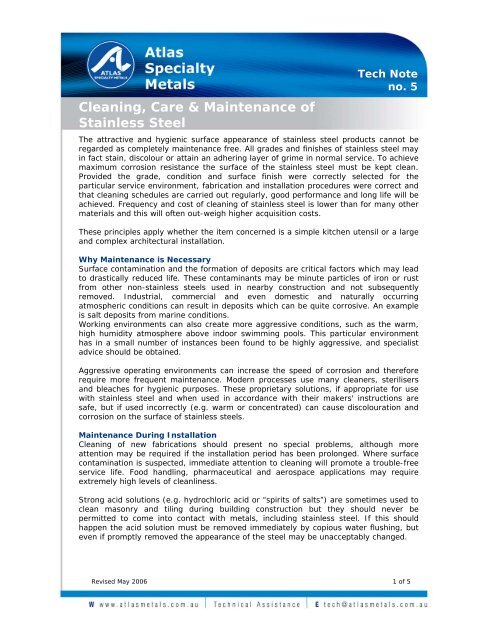


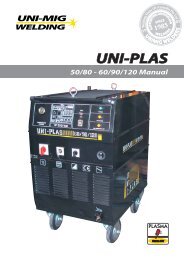
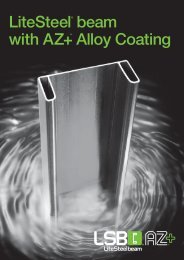

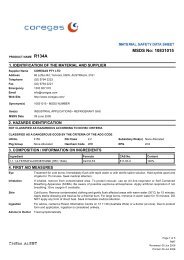
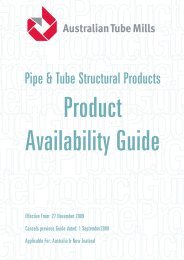
![Weldmatic 175 [internal wirefeeder] - BJH](https://img.yumpu.com/48683580/1/184x260/weldmatic-175-internal-wirefeeder-bjh.jpg?quality=85)



